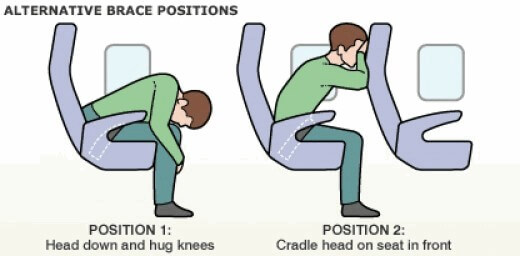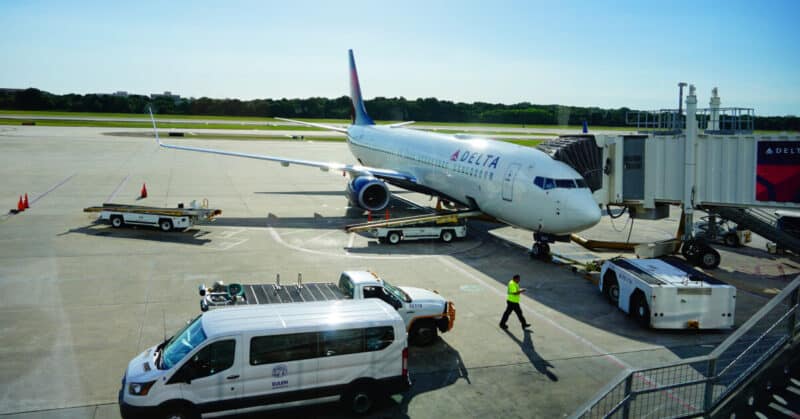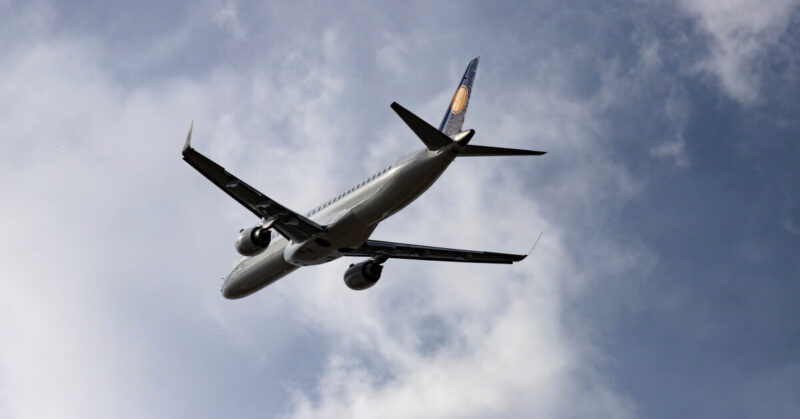We may earn a commission if you buy through some of the links on this page, at no cost to you. Advertising policy
Recent news coverage of horrific air disasters may have piqued your interest in learning how to survive a plane crash, but in actuality airplanes are one of the safest modes of travel. In fact, the likelihood that your plane will crash is infinitesimally small: in 2020, there were only 40 accidents involving large commercial passenger planes, out of a total of 24.4 million flights, according to Dutch aviation consulting firm To70.
That amounts to a .00016 percent chance that your plane will crash. Your odds of being involved in an airplane crash with at least one fatality are even lower – about 1 in 4,880,000 or .00002 percent.
If you do happen to be involved in an airplane accident, your chances of survival are quite good. According to the latest statistics from the NTSB, 95.7% of passengers survive plane crashes. However, the survival rate decreases to 76.6% for accidents that are considered survivable but involve fire, severe injury, or substantial damage to the aircraft.
So what can you do, if anything, to make sure that in the unlikely event you experience a severe air crash, you’re one of the passengers that lives? Research shows that there are definite and concrete steps you can take. In fact, experts say that up to 1/3 of all past air accident deaths could have been prevented if the passengers had known what to do ahead of time and had taken the proper steps during the emergency.
Do you know how to quickly get into the brace position and why it’s so important? What’s the first thing you’d do if the captain announced the plane was going down? By taking a few minutes to familiarize yourself with the advice, strategies, and actions below, you’ll be able to answer these questions. More importantly, you’ll significantly increase your chances of surviving any plane crash, severe or not.
Before and during the flight
1. Have a plan
Most injuries and fatalities that occur during airplane accidents are caused by fire or by the impact of the crash itself. No matter where you are seated on the plane in relation to where a fire or impact occurs, your chances of survival are much greater if you’re prepared and ready to act. Before you fly, you should have an emergency plan, know it, and be ready to execute it.
Fatality rates increase markedly after the first 90 seconds following a plane crash. You can greatly increase your chances of surviving an airplane crash if you take a few moments to look around the cabin and think about what you might do to survive in the event the plane goes down. As researcher Helen Muir from Cranfield University suggests, you should be prepared to make the most of any opportunities near you for survival and escape.
One of the best things you can do to increase your odds of surviving a plane crash is also one of the most obvious: know where the emergency exits are. Once you are settled in your seat, count the rows to the nearest exit in front of and behind you so that you can feel your way in the dark if necessary. Write the number on your hand in pen if necessary.
By being mentally prepared, you’ll naturally be more ready for physical action at a moment’s notice. Learn the strategies below and incorporate them into your plan. When the time comes, act. Don’t count on others to save your life.
2. Choose your seat wisely
Let’s be clear: the number one factor in whether or not you survive a plane crash is the nature of the accident itself. For example, if you’re sitting in the rear of the plane and the impact occurs primarily in the rear, then you’re going to have a lower chance of survival than passengers in the middle and front of the plane. That being said, recent studies suggest that certain seats are safer than others.
Officially, the FAA states that no seat on an airplane is safer than any other. Aircraft manufacturers Airbus and Boeing echo this sentiment, saying that one seat is as safe as another if the passenger is using a seat belt. Study results support this idea to a certain extent, with the survival patterns of several crashes being completely random with regard to seat location. However, evidence exists that is both ample and strong enough to answer the following questions:
Where’s the safest place to sit on an airplane? According to recent studies, the safest place to sit is in the rear third of the plane, with the last row deemed the very safest because it’s closest to the rear exit.
- The 5 Row Rule: Your chances of surviving a plane crash are much greater if your seat is within five rows of an exit. The reason for this is simple: plane crash survivors travel an average of five rows to reach an exit after a crash. Those traveling farther than five rows to an exit had a significantly higher fatality rate.
Which seats on a plane are the least safe? Seats in the middle third of the cabin tend to have a lower survival rate than other seats, as do seats in the front third of the plane, especially the first four rows (usually first class).
Are aisle seats safer than window seats? A 2008 study by the University of Greenwich found that survival in aisle seats was higher than other seats, but noted that “being seated on the aisle provides only a marginally higher chance of survival than not sitting on the aisle”. In contrast, a 2015 study by Time magazine of air crashes since 1985 suggests that aisle seats are the least safe throughout the plane, with aisle seats in the middle third of the cabin having the worst fatality rate. According to the Time study, middle seats in the rear third of the plane are the safest overall.
3. Dress appropriately
The clothing you wear on the airplane could help make the difference between life and death in the event of a crash. Wear a long-sleeve shirt (shirts without buttons are best) and long pants. Wear flame-resistant clothing if possible (most western and work clothing retailers carry this, from Carhartt and other brands).
Avoid polyester, nylon, and acrylic as these materials melt at low temperatures and will stick to and burn your skin. Cotton is preferred, as it is less flammable. Wool is better when flying over water as it won’t lose its insulating properties as quickly when wet, but be aware that it will become much heavier in the water. Don’t wear shorts, dresses, skirts, or loose fitting, flowing clothing.
Make sure to have sturdy, comfortable, lace-up shoes with good soles and traction. Do not wear sandals, high heels, or slip-on shoes. Your escape from a burning plane could depend on it.
4. Pay attention to the safety briefing
Fifty percent of airline passengers report not paying attention during the pre-flight safety presentation, and eighty-nine percent don’t read the safety information cards in the seat-back pockets in front of them. For every flight you are on, you should know where all safety devices and features, like life jackets, are stored and how to access them in case of emergency.
Every aircraft has different safety features and procedures, so it’s a mistake to assume you are already familiar with the pertinent safety information. Even experienced flyers should pay attention to the safety aids provided as this information could be essential during an emergency.
5. The Plus Three, Minus Eight Rule
The name of the plus three, minus eight rule refers to the fact that eighty percent of all plane crashes occur during takeoff and landing – the first three minutes and final eight minutes of the flight, respectively. Remain aware and alert during this time – don’t read or otherwise distract yourself. Be ready, if necessary, to execute your plan. Another recommendation from the experts: have your shoes on during this time, just in case.
6. Seat belts, seat belts, seat belts
It’s probably not a shock that passengers who are wearing seat belts during airplane crashes are much more likely to survive than those who aren’t. What may surprise you is how many passengers reported losing valuable time due to difficulty removing their seat belts. Unlike car seat belts, seat belts in aircraft usually don’t release with the push of a button. While it’s important to wear your seat belt whenever you’re seated during your flight, it’s equally important to take a few minutes to familiarize yourself with its operation, by sight and by touch, so that in the event of an emergency, you’ll be able to release the belt, even if the cabin is dark.
When you fasten your seat belt, pull it as tight as you can. Every centimeter of slack in the belt triples the g-force you’ll experience in a crash. Pull the belt down over your pelvis as much as possible, with the upper ridge of the pelvic bone above the belt. This will keep you in place much more effectively during a crash than if the belt was over the soft tissues and organs of your abdomen.
Leave your seat belt on at all times when seated, especially when sleeping. In most cases, you won’t have time to fully wake up and react before the crash occurs, so it’s important to be securely fastened to your seat ahead of time.
7. Use carryon luggage to pad your legs
Place your carryon bag under the seat in front of you, rather than in the overhead bin. While it will definitely reduce your legroom, it will also help prevent your legs from flying forward in a crash and reduced the chances you’ll break your shin or ankle bones. You’re going to have a much better chance at surviving a plane crash if you can still walk after the initial impact.
During the crash and evacuation
In most cases, you’ll know the plane is going to crash before it actually does. The cabin crew will likely be issuing instructions; listen and follow them carefully. Use this time to go over your plan, especially exit locations and distance from your seat.
If the plane is going down over water, put on your life vest but don’t inflate it until you are out of the airplane. An inflated life vest will make it more difficult to get out of the plane, whether the plane is submerged in water or not. Hold your breath and swim out of the plane, then inflate the life vest.
8. Pad and prepare your space
Secure any loose items in the vicinity. Tie your shoes tightly. Put on and zip up your jacket. If you can, pad your head with a pillow, coat, blanket, or other soft object. Also try to pad your shins and ankles, if possible.
9. Brace for impact
Both anecdotal and empirical evidence show that assuming the brace position or crash position as instructed in the pre-flight safety presentation prior to impact greatly increases your chances of not only surviving a plane crash, but reducing the chances of severe injury if you do survive. Fatalities in plane crashes are more likely to result from impact injuries than any other single cause. There are numerous reports of accidents where most passengers died and only a few walked away, reporting that they had been in the brace position at the time of impact.
When performed properly, the brace position reduces injury to the head, neck, and legs. It also helps prevent whiplash, keeps you from flying around the interior of the cabin, and protects you from flying objects, at least to a certain extent. If you assume the brace position prior to impact, you’re less likely to be concussed and less likely to sustain broken limbs. The brace position is perhaps the single most important thing you can do to survive an imminent plane crash.

How to perform the brace position: Place your feet flat on the floor, as far back under your knees as possible to reduce shin injury. If you can reach the seat in front of you, place one hand palm down on the back or top of the seat. Cross the other hand palm down over the first hand. Rest your forehead against your hands. Don’t lace your fingers.
Alternately, you can rest your head against the seat in front if you. Lace your fingers behind your head, cradling the sides of your head with your arms.
If you can’t reach the seat in front of you or there isn’t one, bend forward with your chest on your thighs, cross your wrists and grab your ankles. You can also grab your calves, with the wrists uncrossed, or lace your fingers behind your head, cradling the sides of your head with your arms.
Stay in the brace position until the plane comes to a complete stop. After the initial crash, there may be additional impacts to the plane.
10. Use the oxygen mask
If the cabin becomes de-pressurized, you have 15-20 seconds to put on your oxygen mask before you become unconscious. Put it on immediately, before assisting children or other passengers. You’re no good to anyone if you’re unconscious during an emergency.
11. Hold on to something solid
In the event of a free fall or if the plane breaks apart in mid-air, you should hold on to the most solid, substantial thing you can find. It may sound improbable but there are instances where people have actually ridden solid objects like seats or other parts of the plane and survived falls of thousands of feet without a parachute.
The most incredible story told by these so-called “wreckage riders” is that of Vesna Vulovic, a flight attendant on a Yugoslav DC 9 jet airliner that blew up in January of 1972. Despite falling more than 33,000 feet, she was able to survive by holding on to a food cart. She was initially paralyzed after the fall but later recovered the ability to walk.
After the crash
12. Follow instructions
Flight crews are trained to know how to respond in the event of a crash. Listen to them and follow their instructions.
13. Get out now
Fatality rates increase significantly after the first 90 seconds following a plane crash. Follow the instructions of the cabin crew, but if they’re dazed, disoriented, or dead, don’t wait. Get out of the cabin as fast as you can and as far from the plane as possible.
If the nearest exit is behind you and accessible, ignore the human propensity to move forward rather than backward and move to the rearward exit. Assess the exit for safety – look out the window to see if there are any hazards present. If so, proceed to the exit on the opposite side of the plane or the next closest exit.
Leave your luggage. Don’t waste valuable time looking for belongings that mean little in a life or death situation. If necessary, you can return to the plane later for anything that’s salvageable.
14. Don’t climb seats
Studies have shown that following a plane crash, most seat climbers do so because other avenues are blocked and they are simply moving around the obstruction. Research suggests that passengers within two rows of an exit, on the other hand, may attempt to climb seats if the aisle is congested in order to reach the exit more quickly. However, the result is that the exit row becomes even more congested, increasing the time it takes for all passengers, including the seat climbers, to exit.
15. Stay low
Most fatalities are due to post-crash smoke, fumes, and fire. In case of smoke or other fumes in the cabin, be prepared to stay as low as possible while still evacuating the plane as quickly as you can. Cover your nose and mouth with a cloth, moistened if possible. Consider carrying a portable, heat-resistant smoke hood, available from many retailers.
16. Move away from the plane
The plane may explode or erupt in fire. Move at least 500 feet away from the plane, in an upwind direction. However, stay in the vicinity of the crash so that rescuers can find you.
17. Assess the situation
Do you have any wounds that need to be cared for? If you’re bleeding, apply pressure immediately. Assist others with basic first aid if you’re able.
18. Stay in the area
Rescuers will arrive as soon as possible. Stay in the area so they can find you.
Estimated reading time: 13 minutes
- You might also like:




